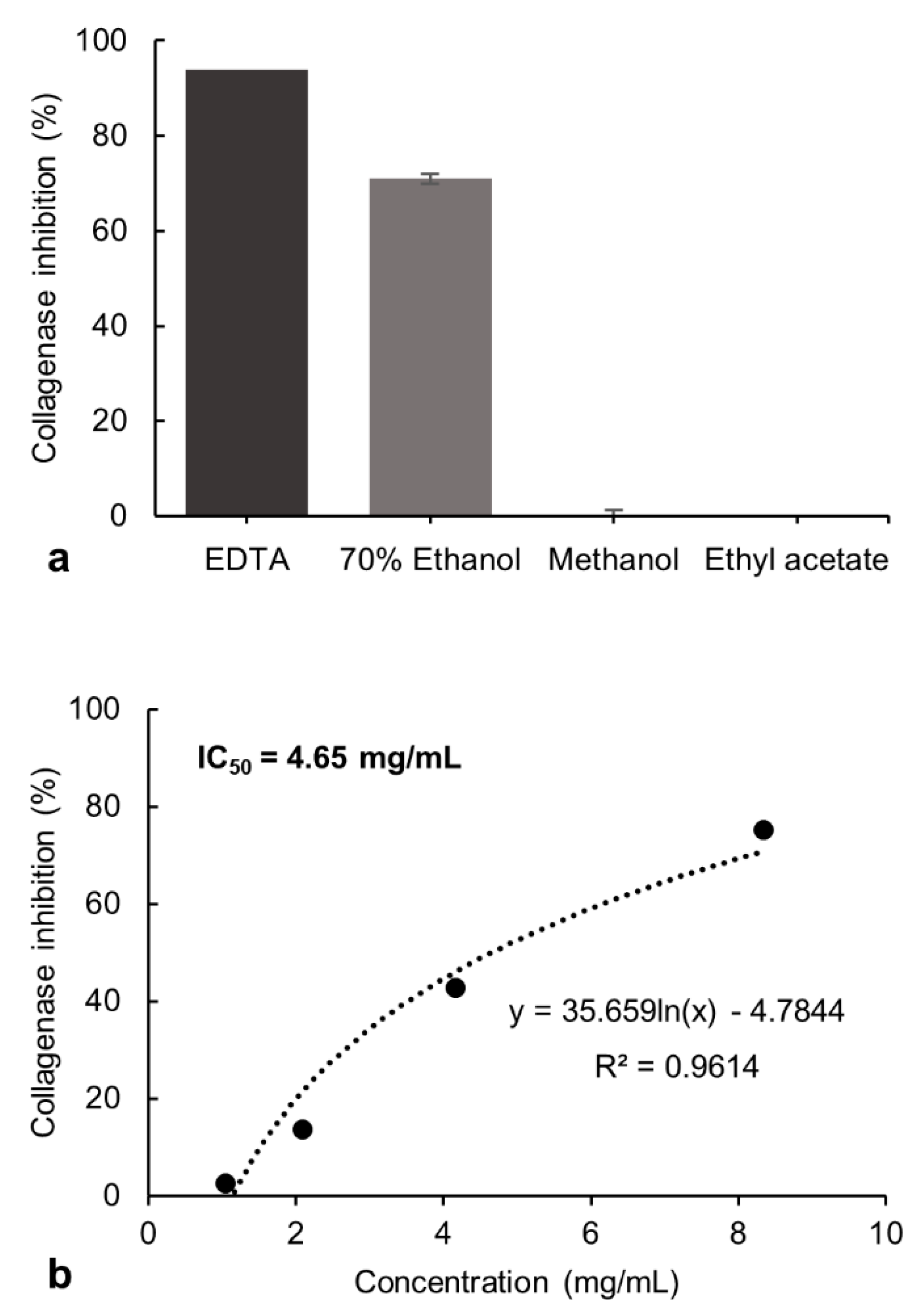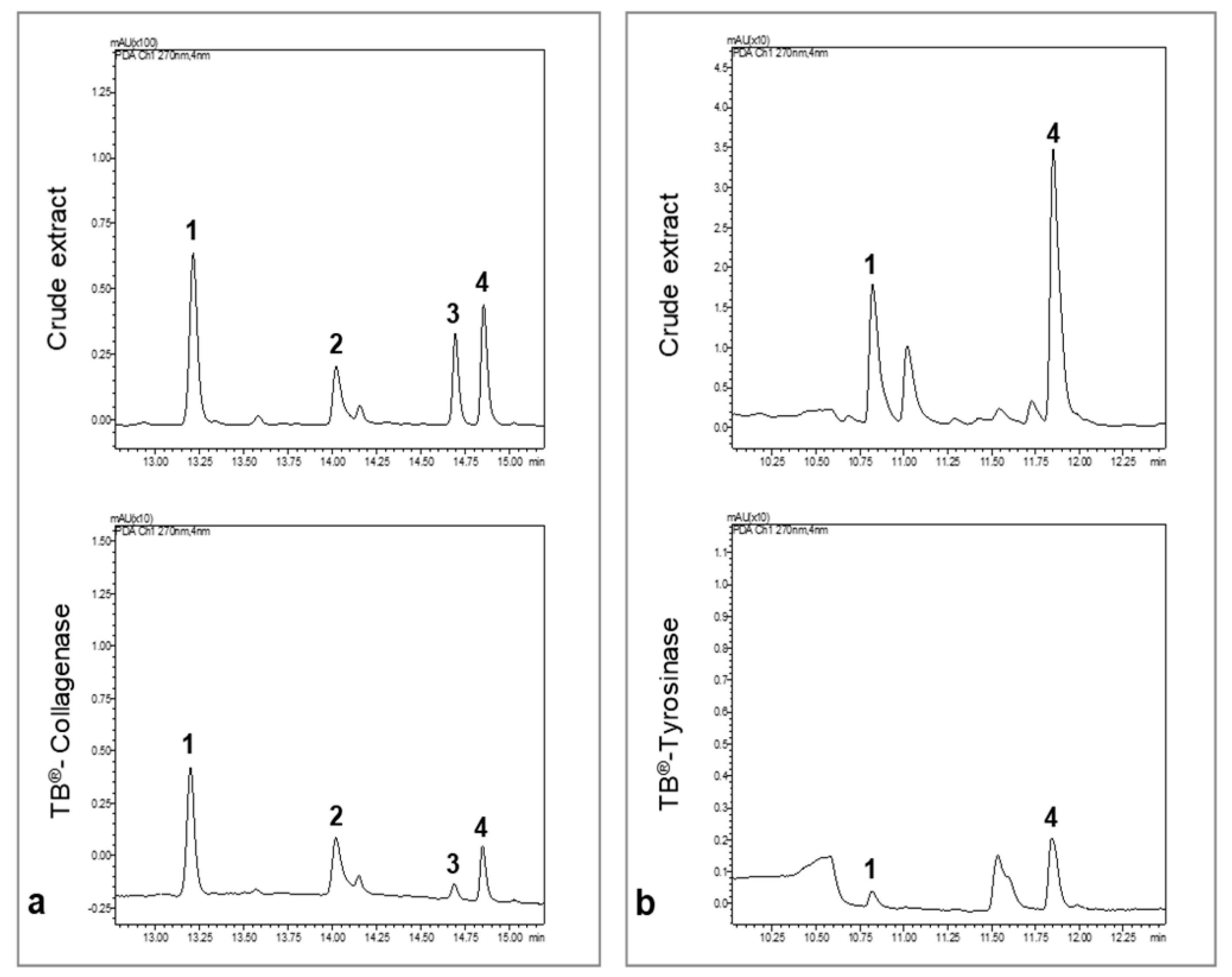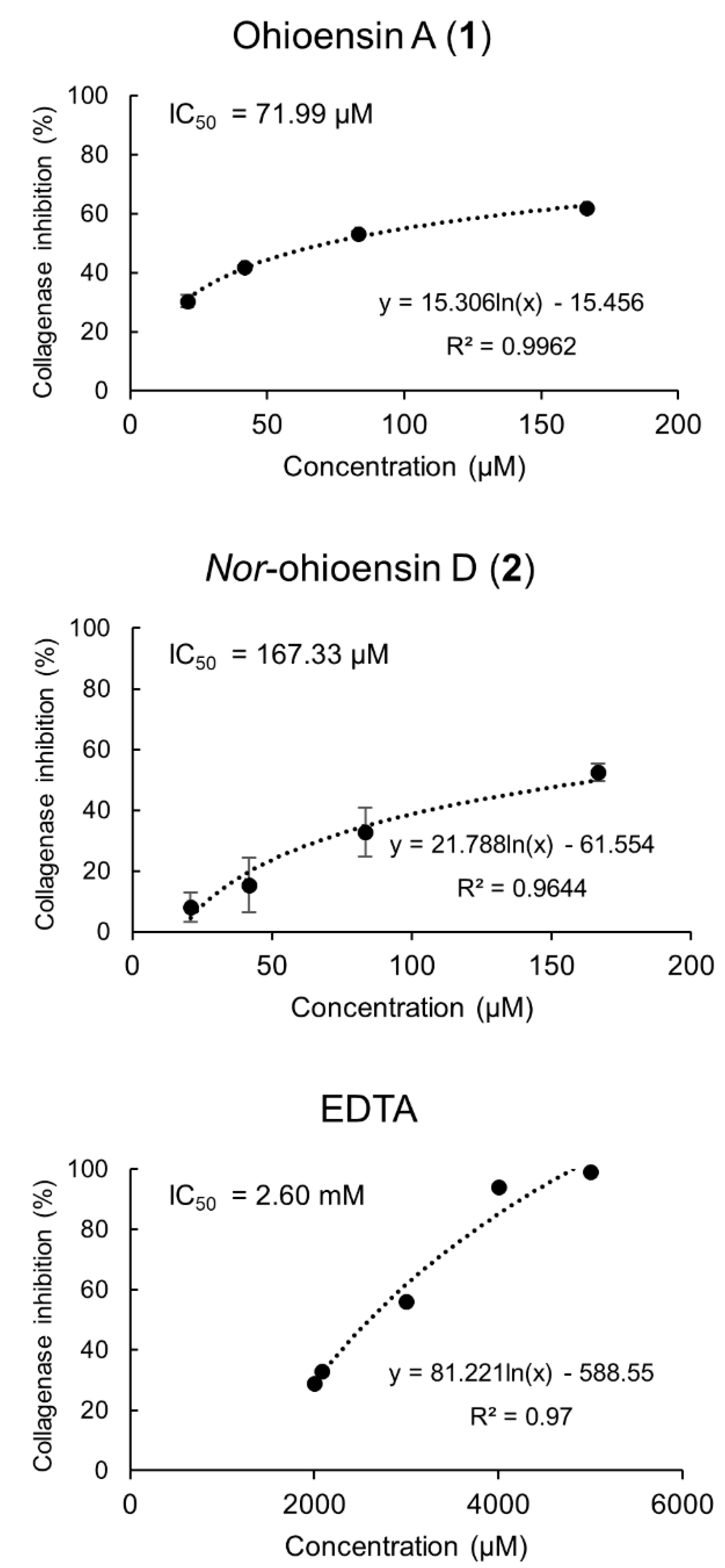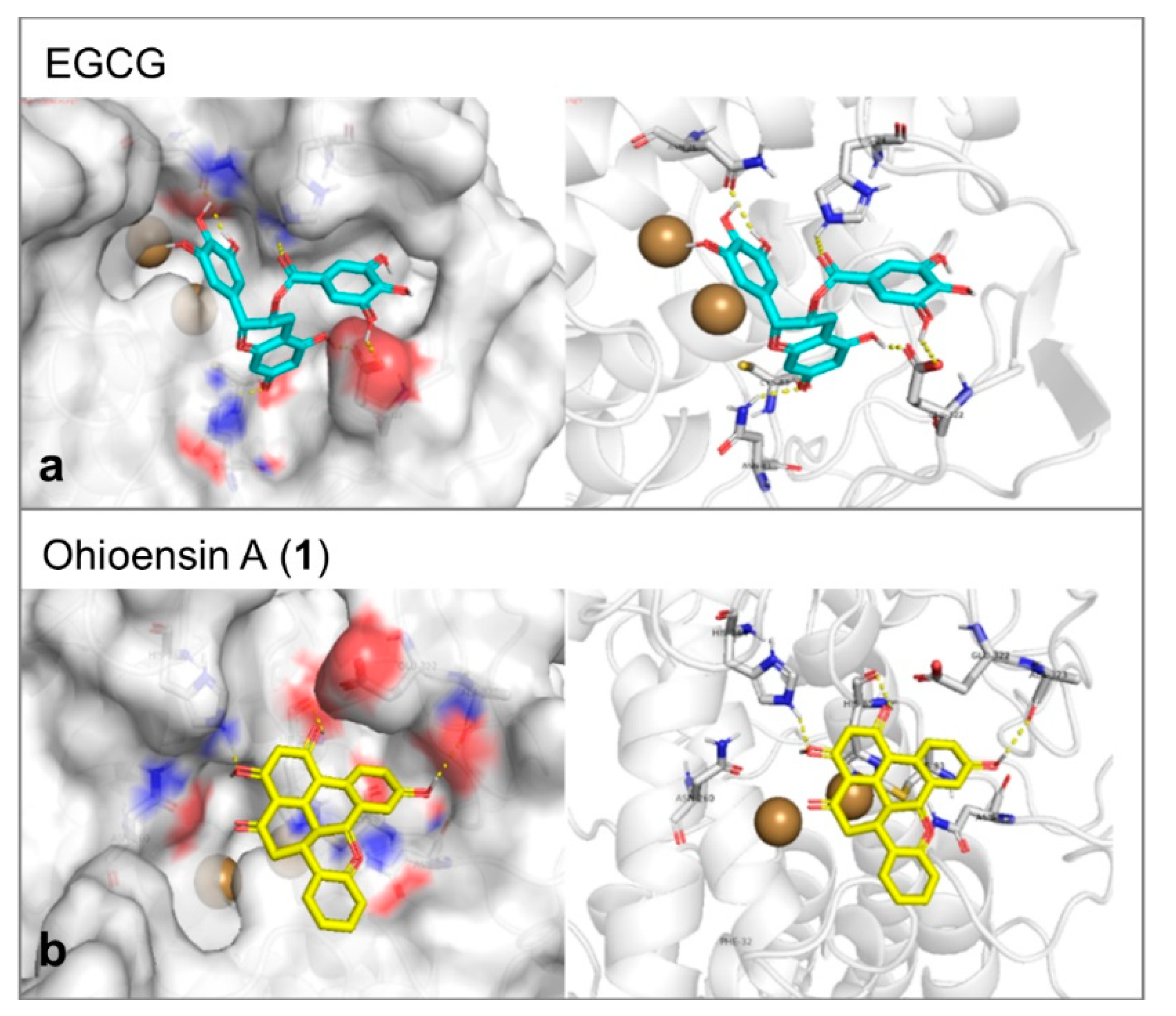Collagenase and Tyrosinase Inhibitory Effect of Isolated Constituents from the Moss Polytrichum formosum
Abstract
:1. Introduction
2. Results and Discussion
2.1. Relative Affinity of P. formosum Metabolites to the Target Enzymes
2.2. Bioactive Compounds Identification
2.3. Collagenase and Tyrosinase Inhibitory Effect of P. formosum Compounds
2.4. Mode of Action of the Bioactive Compounds
3. Materials and Methods
3.1. Plant Material
3.2. Extraction Preparation
3.3. In Vitro Collagenase Assay
3.4. In Vitro Tyrosinase Assay
3.5. Evaluation of Collagenase and Tyrosinase Affinity by Target Binding® Technology
3.6. Isolation and Identification of Constituents
3.7. UHPLC-HRMS Analysis
3.8. NMR Measurement
3.9. Molecular Modeling
3.10. Statistical Analysis
4. Conclusions
Supplementary Materials
Author Contributions
Funding
Data Availability Statement
Acknowledgments
Conflicts of Interest
References
- Asakawa, Y. Biologically Active Compounds from Bryophytes. Pure Appl. Chem. 2007, 79, 557–580. [Google Scholar] [CrossRef]
- Sabovljević, M.S.; Sabovljević, A.D.; Ikram, N.K.K.; Peramuna, A.; Bae, H.; Simonsen, H.T. Bryophytes-an Emerging Source for Herbal Remedies and Chemical Production. Plant Genet. Resour. Charact. Util. 2016, 14, 314–327. [Google Scholar] [CrossRef]
- Akinori, H.; Akira, H.; Taizo, S.; Yuki, Y. Cell Activator, Collagen Production Promoter, Melanin Production Inhibitor, Hyaluronic Acid Production Promoter and Skin Care Preparation. JP Patent 2003321376A, 3 June 2003. [Google Scholar]
- Zheng, G.; Chang, C.; Stout, T.J.; Clardy, J.; Ho, D.K.; Cassady, J.M. Ohioensins: Novel Benzonaphthoxanthenones from Polytrichum Ohioense. J. Org. Chem. 1993, 58, 366–372. [Google Scholar] [CrossRef]
- Zheng, G.; Chang, C.; Stout, T.J.; Clardy, J.; Cassady, J.M. Ohioensin-A: A Novel Benzonaphthoxanthenone from Polytrichum Ohioense. J. Am. Chem. Soc. 1989, 111, 5500–5501. [Google Scholar] [CrossRef]
- Seo, C.; Choi, Y.-H.; Sohn, J.H.; Ahn, J.S.; Yim, J.H.; Lee, H.K.; Oh, H. Ohioensins F and G: Protein Tyrosine Phosphatase 1B Inhibitory Benzonaphthoxanthenones from the Antarctic Moss Polytrichastrum Alpinum. Bioorgan. Med. Chem. Lett. 2008, 18, 772–775. [Google Scholar] [CrossRef] [PubMed]
- Bhattarai, H.D.; Paudel, B.; Lee, H.K.; Oh, H.; Yim, J.H. In Vitro Antioxidant Capacities of Two Benzonaphthoxanthenones: Ohioensins F and G, Isolated from the Antarctic Moss Polytrichastrum Alpinum. Z. Naturforsch. C 2009, 64, 197–200. [Google Scholar] [CrossRef]
- Byeon, H.E.; Um, S.H.; Yim, J.H.; Lee, H.K.; Pyo, S. Ohioensin F Suppresses TNF-α-Induced Adhesion Molecule Expression by Inactivation of the MAPK, Akt and NF-ΚB Pathways in Vascular Smooth Muscle Cells. Life Sci. 2012, 90, 396–406. [Google Scholar] [CrossRef]
- Guo, Z.-F.; Bi, G.-M.; Zhang, Y.-H.; Li, J.-H.; Meng, D.-L. Rare Benzonaphthoxanthenones from Chinese Folk Herbal Medicine Polytrichum Commune and Their Anti-Neuroinflammatory Activities in Vitro. Bioorgan. Chem. 2020, 102, 104087. [Google Scholar] [CrossRef]
- Madzharova, E.; Kastl, P.; Sabino, F.; auf dem Keller, U. Post-Translational Modification-Dependent Activity of Matrix Metalloproteinases. Int. J. Mol. Sci. 2019, 20, 3077. [Google Scholar] [CrossRef] [PubMed] [Green Version]
- Kisling, A.; Lust, R.M.; Katwa, L.C. What Is the Role of Peptide Fragments of Collagen I and IV in Health and Disease? Life Sci. 2019, 228, 30–34. [Google Scholar] [CrossRef]
- Amar, S.; Smith, L.; Fields, G.B. Matrix Metalloproteinase Collagenolysis in Health and Disease. Biochim. Biophys. Acta Mol. Cell Res. 2017, 1864, 1940–1951. [Google Scholar] [CrossRef] [PubMed]
- Ågren, M.S. Matrix Metalloproteinases: How Much Can They Do? Int. J. Mol. Sci. 2020, 21, 2678. [Google Scholar] [CrossRef]
- Avila Rodríguez, M.I.; Rodríguez Barroso, L.G.; Sánchez, M.L. Collagen: A Review on Its Sources and Potential Cosmetic Applications. J. Cosmet. Dermatol. 2018, 17, 20–26. [Google Scholar] [CrossRef]
- Gu, Y.; Han, J.; Jiang, C.; Zhang, Y. Biomarkers, Oxidative Stress and Autophagy in Skin Aging. Ageing Res. Rev. 2020, 59, 101036. [Google Scholar] [CrossRef] [PubMed]
- Gillbro, J.M.; Olsson, M.J. The Melanogenesis and Mechanisms of Skin-Lightening Agents—Existing and New Approaches. Int. J. Cosmet. Sci. 2011, 33, 210–221. [Google Scholar] [CrossRef]
- Bae-Harboe, Y.S.C.; Park, H.Y. Tyrosinase: A Central Regulatory Protein for Cutaneous Pigmentation. J. Investig. Dermatol. 2012, 132, 2678–2680. [Google Scholar] [CrossRef] [Green Version]
- Speeckaert, R.; Van Gele, M.; Speeckaert, M.M.; Lambert, J.; van Geel, N. The Biology of Hyperpigmentation Syndromes. Pigment Cell Melanoma Res. 2014, 27, 512–524. [Google Scholar] [CrossRef] [PubMed]
- Chajra, H.; Salwinski, A.; Guillaumin, A.; Mignard, B.; Hannewald, P.; Duriot, L.; Warnault, P.; Guillet-Claude, C.; Fréchet, M.; Bourgaud, F. Plant Milking Technology: An Innovative and Sustainable Process to Produce Highly Active Extracts from Plant Roots. Molecules 2020, 25, 4162. [Google Scholar] [CrossRef]
- Auld, D.S. Removal and Replacement of Metal Ions in Metallopeptidases. Methods Enzymol. 1995, 248, 228–242. [Google Scholar] [CrossRef]
- Saruno, R.; Kato, F.; Ikeno, T. Kojic Acid, a Tyrosinase Inhibitor from Aspergillus Albus. Agric. Biol. Chem. 1979, 43, 1337–1338. [Google Scholar] [CrossRef]
- Fu, P.; Lin, S.; Shan, L.; Lu, M.; Shen, Y.-H.; Tang, J.; Liu, R.-H.; Zhang, X.; Zhu, R.-L.; Zhang, W.-D. Constituents of the Moss Polytrichum Commune. J. Nat. Med. 2009, 72, 1335–1337. [Google Scholar] [CrossRef]
- Lu, W.; Zhu, J.; Zou, S.; Li, X.; Huang, J. The Efficient Expression of Human Fibroblast Collagenase in Escherichia Coli and the Discovery of Flavonoid Inhibitors. J. Enzym. Inhib. Med. Chem. 2013, 28, 741–746. [Google Scholar] [CrossRef]
- Nguyen, T.T.H.; Moon, Y.-H.; Ryu, Y.-B.; Kim, Y.-M.; Nam, S.-H.; Kim, M.-S.; Kimura, A.; Kim, D. The Influence of Flavonoid Compounds on the in Vitro Inhibition Study of a Human Fibroblast Collagenase Catalytic Domain Expressed in E. Coli. Enzym. Microb. Technol. 2013, 52, 26–31. [Google Scholar] [CrossRef]
- Crascì, L.; Basile, L.; Panico, A.; Puglia, C.; Bonina, F.P.; Basile, P.M.; Rizza, L.; Guccione, S. Correlating in Vitro Target-Oriented Screening and Docking: Inhibition of Matrix Metalloproteinases Activities by Flavonoids. Planta Med. 2017, 83, 901–911. [Google Scholar] [CrossRef] [PubMed] [Green Version]
- Sim, G.S.; Lee, B.C.; Cho, H.S.; Jae, W.L.; Kim, J.H.; Lee, D.H.; Kim, J.H.; Pyo, H.B.; Dong, C.M.; Oh, K.W.; et al. Structure Activity Relationship of Antioxidative Property of Flavonoids and Inhibitory Effect on Matrix Metalloproteinase Activity in UVA-Irradiated Human Dermal Fibroblast. Arch. Pharm. Res. 2007, 30, 290–298. [Google Scholar] [CrossRef]
- Madhan, B.; Krishnamoorthy, G.; Rao, J.R.; Nair, B.U. Role of Green Tea Polyphenols in the Inhibition of Collagenolytic Activity by Collagenase. Int. J. Biol. Macromol. 2007, 41, 16–22. [Google Scholar] [CrossRef] [PubMed]
- Jackson, J.K.; Zhao, J.; Wong, W.; Burt, H.M. The Inhibition of Collagenase Induced Degradation of Collagen by the Galloyl-Containing Polyphenols Tannic Acid, Epigallocatechin Gallate and Epicatechin Gallate. J. Mater. Sci. Mater. Med. 2010, 21, 1435–1443. [Google Scholar] [CrossRef] [PubMed]
- Kamkaen, N.; Mulsri, N.; Treesak, C. Screening of Some Tropical Vegetables for Anti-Tyrosinase Activity. Thai Pharm. Health Sci. J. 2007, 2, 15–19. [Google Scholar]
- Salwinski, A. Method for Determining Affinity between Ligands and a Target. WO2018055053A1, 23 September 2016. [Google Scholar]
- RCSB PDB—2Y6I: Crystal Structure of Collagenase G from Clostridium Histolyticum in Complex with Isoamylphosphonyl-Gly-Pro-Ala at 3.25 Angstrom Resolution. Available online: https://www.rcsb.org/structure/2y6i (accessed on 8 February 2021).
- RCSB PDB—2Y9W: Crystal Structure of PPO3, a Tyrosinase from Agaricus Bisporus, in Deoxy-Form That Contains Additional Unknown Lectin-Like Subunit. Available online: https://www.rcsb.org/structure/2y9w (accessed on 8 February 2021).
- Pedretti, A.; Villa, L.; Vistoli, G. VEGA—An Open Platform to Develop Chemo-Bio-Informatics Applications, Using Plug-in Architecture and Script Programming. J. Comput. Aided Mol. Des. 2004, 18, 167–173. [Google Scholar] [CrossRef]
- Trott, O.; Olson, A.J. AutoDock Vina: Improving the Speed and Accuracy of Docking with a New Scoring Function, Efficient Optimization, and Multithreading. J. Comput. Chem. 2010, 31, 455–461. [Google Scholar] [CrossRef] [Green Version]
- Reski, R.; Bae, H.; Simonsen, H.T. Physcomitrella Patens, a Versatile Synthetic Biology Chassis. Plant Cell Rep. 2018, 37, 1409–1417. [Google Scholar] [CrossRef] [PubMed]
- Ruiz-Molina, N.; Ortega-Bedoya, I.; Arias-Zabala, M. Protonema Suspension Cultures of Polytrichum Juniperinum as a Potential Production Platform for Bioactive Compounds. J. Herbs Spices Med. Plants 2019, 25, 114–127. [Google Scholar] [CrossRef]








| Compounds | Ohioensin A (1) | Nor-Ohioensin D (2) | Ohioensin C (3) | Communin B (4) |
|---|---|---|---|---|
| Relative affinity for collagenase * | 4.76 | 6.76 | 1 | 2.76 |
| Relative affinity for tyrosinase ** | 1 | - | - | 3.14 |
Publisher’s Note: MDPI stays neutral with regard to jurisdictional claims in published maps and institutional affiliations. |
© 2021 by the authors. Licensee MDPI, Basel, Switzerland. This article is an open access article distributed under the terms and conditions of the Creative Commons Attribution (CC BY) license (https://creativecommons.org/licenses/by/4.0/).
Share and Cite
Marques, R.V.; Guillaumin, A.; Abdelwahab, A.B.; Salwinski, A.; Gotfredsen, C.H.; Bourgaud, F.; Enemark-Rasmussen, K.; Miguel, S.; Simonsen, H.T. Collagenase and Tyrosinase Inhibitory Effect of Isolated Constituents from the Moss Polytrichum formosum. Plants 2021, 10, 1271. https://doi.org/10.3390/plants10071271
Marques RV, Guillaumin A, Abdelwahab AB, Salwinski A, Gotfredsen CH, Bourgaud F, Enemark-Rasmussen K, Miguel S, Simonsen HT. Collagenase and Tyrosinase Inhibitory Effect of Isolated Constituents from the Moss Polytrichum formosum. Plants. 2021; 10(7):1271. https://doi.org/10.3390/plants10071271
Chicago/Turabian StyleMarques, Raíssa Volpatto, Agnès Guillaumin, Ahmed B. Abdelwahab, Aleksander Salwinski, Charlotte H. Gotfredsen, Frédéric Bourgaud, Kasper Enemark-Rasmussen, Sissi Miguel, and Henrik Toft Simonsen. 2021. "Collagenase and Tyrosinase Inhibitory Effect of Isolated Constituents from the Moss Polytrichum formosum" Plants 10, no. 7: 1271. https://doi.org/10.3390/plants10071271
APA StyleMarques, R. V., Guillaumin, A., Abdelwahab, A. B., Salwinski, A., Gotfredsen, C. H., Bourgaud, F., Enemark-Rasmussen, K., Miguel, S., & Simonsen, H. T. (2021). Collagenase and Tyrosinase Inhibitory Effect of Isolated Constituents from the Moss Polytrichum formosum. Plants, 10(7), 1271. https://doi.org/10.3390/plants10071271







